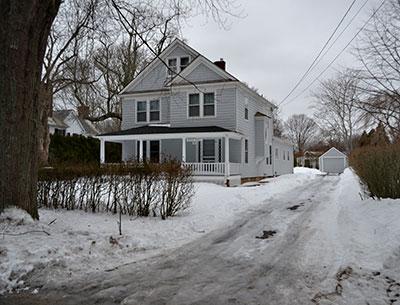More Money, or the ‘Big Picture’?

A proposed subdivision that set members of the East Hampton Town Planning Board at odds when they first discussed it in October had a three-hour hearing on Feb. 3 before the zoning board of appeals, during which members asked hard questions of both sides.
The 48,984-square-foot property, a narrow strip of land at 38 Indian Wells Highway in Amagansett, runs west to Further Court. It has been in the family of the current owner, Thomas Onisko, for many years. It contains two houses, a large one that takes access from Indian Wells Highway and a smaller house behind it that is reached via a long driveway from Further Court.
Mr. Onisko proposes to split the property roughly in half, creating two nonconforming lots, each roughly a half-acre. The small house would be demolished and a new house built on the back lot.
The property as it now stands conforms with the neighborhood zoning, which calls for lots of at least one acre.
Should the subdivision be approved, Mr. Onisko’s representatives told the board, his overriding benefit would be financial. Britton Bistrian, a land planner, made that clear from the beginning of her presentation, and Rick Slater, a real estate broker with Town and Country, backed her up, suggesting that the property’s value would increase by 30 percent if it were sold as two lots. He estimated its current value at $3.5 to $4 million.
Assuming the subdivision is approved, Mr. Onisko already has a buyer, Todd Davidson, whose representative, Richard E. Whalen of Land Marks, made it clear that his client would back out if approval were not granted. Mr. Davidson intends to finance the purchase by selling the back lot, Mr. Whalen explained. “There is a substantial economic loss if the subdivision is not granted,” he said.
Theodore Sklar of Esseks, Hefter, and Angel addressed the board on behalf of the Further Court couple whose land borders the smaller house, Allen Lester Grebetz and Andrew Peters. They purchased their 1.3-acre property a couple of years ago not knowing there was any possibility of a subdivision next door, he said. Mr. Sklar also presented the board with affidavits from other neighbors opposing any subdivision, and suggested that the justification for “an unprecedented subdivision” was that there was a buyer in place.
Don Cirillo, a board member, seemed sympathetic. “Somebody buys a property in good faith, and all of a sudden there are two properties, with two houses for sale,” he said.
John Whelan, the Z.B.A.’s chairman, appeared a bit taken aback by the repeated discussion of money. “Just because something is presented by you or an applicant in a public hearing about something being on the market or not,” he told Mr. Sklar, “that does not mean that is what we are basing our determination on. This board is looking at the big picture . . . my judgment is not based on a real estate deal. It is based on zoning and the future of the land.”
The size of the potential houses if the property were subdivided was a focus for much of the evening. Mr. Whalen said that if the board turned down the application, the property owner could by right increase the size of both houses to almost 7,500 square feet of gross floor area.
Eric Schantz, an East Hampton Town planner, disputed that assertion, saying that it was counter to town policy. The figure used by Mr. Whalen, he said, was in fact the total that would be allowed for both structures on the one lot. If the application were approved, Mr. Schantz said, the two properties together would be allowed about 9,000 square feet.
An expert for Mr. Grebetz and Mr. Peters, Charles W. Bowman, presented the board with images of what a new house on the back lot might look like. They showed a three-story structure looming over the neighbors’ property.
Mr. Whelan objected, citing the narrowness of the property. The pyramid law would preclude such a looming presence, he said.
The planning board came in for some potshots later in the meeting. Mr. Sklar said it had met in October to prepare comments on the application for the Z.B.A. but had not sent any. Also, he said, the planning board should have done an analysis under the State Environmental Quality Review Act.
“The planning board did declare lead agency status. God knows only why,” Mr. Whalen said. “They need to relinquish lead agency status, or do SEQRA.”
Mr. Schantz assured the zoning board that the planning board would take up SEQRA at its next meeting, which took place last night.
With guidance from Elizabeth Vail, the town attorney present that night, the board agreed to keep the record open for written documents, including a SEQRA determination; additional comments from the planning board, a determination from the Building Department as to what the allowable gross floor area on the property would be if left as is and if divided, and floor plans for the existing houses.
